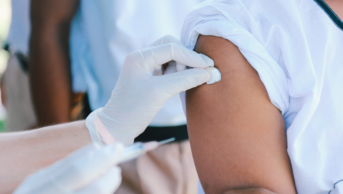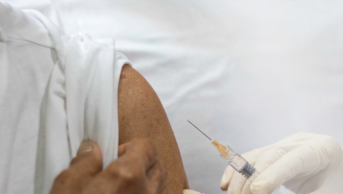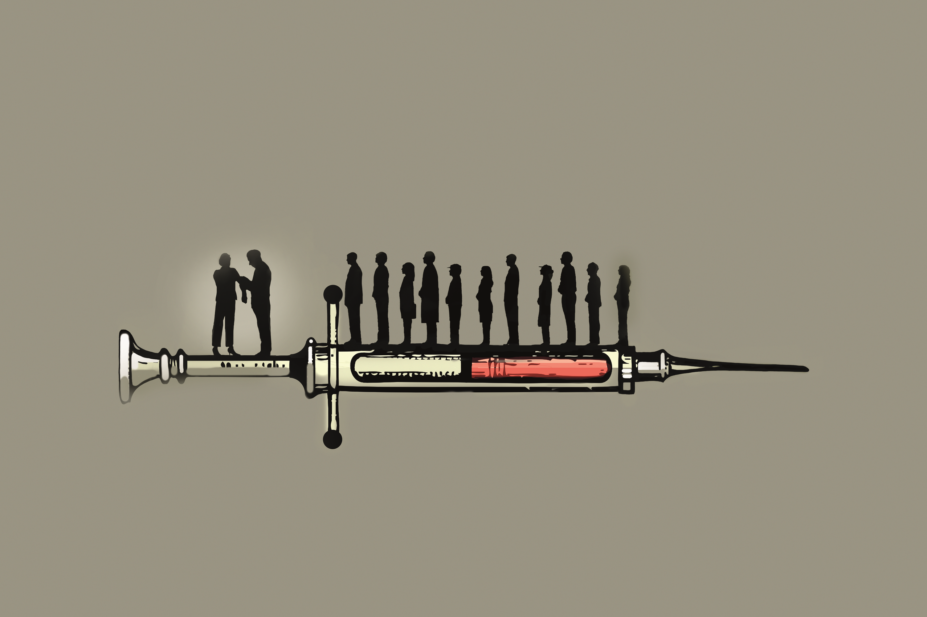
Icon Images
After three years of experience, pharmacists were ready to once again beat expectations and increase the number of NHS flu vaccinations they provided for eligible patients walking in off the street. Keen pharmacy teams may have even discussed plans to beat their previous efforts — in all, 1.3 million flu vaccines were given by pharmacists in 2017.
But then the goalposts were moved. Owing to concerns over the effectiveness of the flu vaccine in older people, government advisers issued new recommendations. After reviewing the available evidence, the Joint Committee on Vaccination and Immunisation advised that those aged over 65 years should receive the adjuvanted trivalent (aTIV) vaccine — otherwise known as Fluad (Seqirus Vaccines Ltd) and licensed for use in August 2017 — and the quadrivalent vaccine should be used for people under the age of 65 years in high-risk groups.
NHS England warned of the guidance changes in February 2018, giving pharmacists just a few weeks before final orders needed to be placed. This set the ball rolling on a series of issues that could make the 2018 flu season the most challenging yet for pharmacy.
Under ‘normal’ circumstances it would be simple for pharmacy to beat the 2017 uptake; some are offering the vaccine for the first time and awareness among the general public that they can access flu vaccination at their local pharmacy is growing. In addition, there has been a welcome uplift in vaccination fee by 34p per vaccine, from £7.64 to £7.98; when including the £1.50 additional fee, this makes for a total payment of £9.48 per vaccine.
But seasoned pharmacists point out that there are myriad factors making the flu service a ‘juggling act’ in 2018, with problems being found throughout the process, including ordering the vaccines, having staggered deliveries and limited supplies, and delivering a walk-in service that follows guidelines on which patients to prioritise.
Deliveries of Fluad
The flu vaccination Fluad is produced by a sole manufacturer, Sequiris, which has assured providers that it will be able to deliver on the 9.3 million doses ordered by GP practices and pharmacies across the UK. After discussions between the company, NHS England, the Pharmaceutical Services Negotiating Committee (PSNC) and the British Medical Association, it was agreed that 2018 supplies would be delivered to GPs, wholesalers and pharmacists in a staggered way — 40% in September, followed by 20% in November and the remaining 40% in December. While far fairer than the alternative free-for-all, it exemplifies perfectly why pharmacists are struggling to plan the 2018 flu service.
Nat Mitchell, pharmacist and director of JWW Allison and Sons in Cockermouth, Cumbria, ran a successful flu vaccination service in 2017. Despite operating a relatively small, independent pharmacy, in 2017 he gave 1,750 flu vaccinations – 1,300 of these to people aged over 65 years. In 2018, he sent his orders in early and his first vaccine deliveries arrived on 15 September; however, despite his previous success, Mitchell fears he may still be left out of pocket as the staggered deliveries make a walk-in service somewhat meaningless. Without the necessary consulting space to book patients in, he cannot prioritise high-risk patients and he says he will not be able to deny lower risk patients the vaccine in order to reserve stocks for higher risk patients who may or may not come in to the pharmacy.
Normally with flu vaccination, you’re in control, but this year it has been taken out of our hands
“Hopefully we have ordered enough to offer it to everyone — we have over-ordered. But there will be people who will be upset even when you explain,” Mitchell says. “Normally with flu vaccination, you’re in control, but this year it has been taken out of our hands.”
Mitchell adds that there has been a lot of suspicion among pharmacists that their local GPs are getting it first. “Because there is only one manufacturer — they say they have enough — people are worried about how it is being spread out across the country.”
GP-first deliveries
The nervousness among pharmacists that vaccine supplies would be impacted by the new guidance has, for some, already become reality. Mike Hewitson, managing director of Beaminster Pharmacy in Dorset, was one of several who realised too late that their order to Sequiris had gone missing. His superintendent pharmacist had placed the order by phone and was asked to fax a form to complete the process; despite complying with the request, his order was cancelled. “The process has been fairly flawed,” explains Hewitson.“My personal opinion is that they couldn’t cope with demand.”
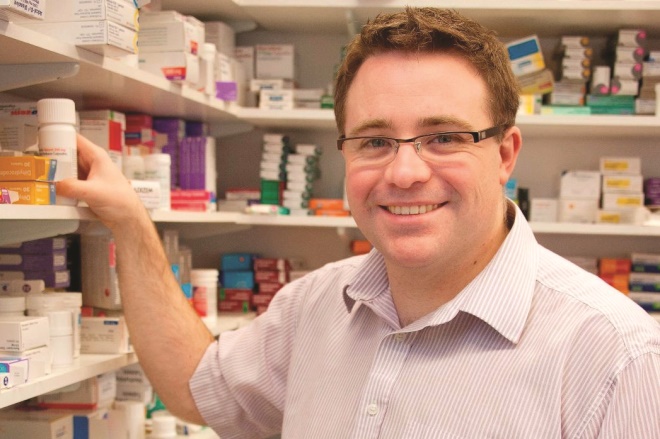
Source: Courtesy of Mike Hewitson
Mike Hewitson, managing director of Beaminster Pharmacy in Dorset, realised too late that his order of the adjuvanted trivalent vaccine had gone missing; this order was later cancelled by the manufacturer
Sequiris admitted some processing challenges during the ordering period “due to the sudden high volume of requests,” but, in a statement issued in September 2018, said that the majority of issues have been resolved. However, it cannot fulfil any late orders because of the “global demand” for the vaccine, the statement added.
Hewitson explains that his pharmacy will still provide vaccines for people aged under 65 years as they have some of the quadrivalent vaccine, but what is most upsetting for his team is that they had previously only carried out 50 vaccinations and wanted to expand the service, trebling their numbers. “It is not massive numbers but we provide a service for people who would not otherwise be vaccinated. We’re really disappointed,” he says.
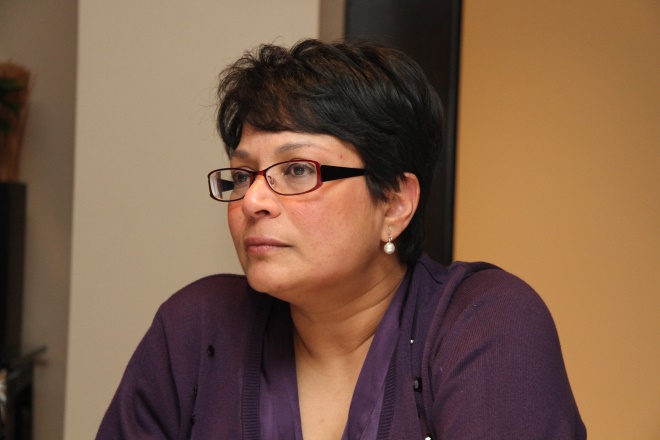
Source: Courtesy of Rekha Shah
Rekha Shah, flu vaccination lead for London’s local pharmaceutical committees says: “The majority of pharmacy orders for September are being delivered in the last week of September, and this is despite having the same postcode as a GP practice with delivery three weeks earlier. Certainly not equitable.”
The PSNC agrees that the 2018 flu season is going to be more challenging than previous years, but says that pharmacists are up to the task. Rekha Shah, flu vaccination lead for London’s local pharmaceutical committees (LPCs) and chief executive officer for Kensington Chelsea and Westminster LPC, believes the issues around getting hold of Fluad are going to have a “massive” impact on the 2018 campaign. In Greater London, despite everyone being promised 40% of their order in September, GPs received supplies in the first week of September while pharmacists are having to wait until the final week of the month, she explains.
“The majority of pharmacy [Fluad] orders for September are being delivered in the last week of September, and this is despite having the same postcode as a GP practice with delivery three weeks earlier. Certainly not equitable,” says Shah.
This is in addition to another problem: that providers — both pharmacists and GPs — did not grasp the importance of placing their orders for Fluad by the cut-off dates because it had never been necessary before, having relied on wholesalers for stock. The deadline for community pharmacies was initially mid-March, although this was extended to 12 April thanks to involvement from the PSNC. But once this deadline was missed, there was no spare vaccine to be sourced through any route — very different to the flexibility in ordering top-up supplies that pharmacists are used to.
The hundreds of pharmacies who did not place their orders in time will have no access to this vaccine
“The wholesalers have already no stock of aTIV left this year and so the hundreds of pharmacies who did not place their orders in time will have no access to this vaccine,” says Shah. Wholesalers have made it clear that any stocks they have are designated, and there will be no extra.
Prioritising vaccines
When viewed with the reports of lost orders before the flu vaccination campaign even started, it is clear that there have already been some logistical major headaches. The experience that pharmacy has gained in the past three years with delivering flu vaccines and increasing the number of people receiving the service is to a certain extent irrelevant in the 2018 season, given the number of unknown variables to contend with.
“We build on the learning from each year and it normally gets easier to organise and plan,” says Shah. “This year there are all the different issues to do with different variants of vaccine to be used in different age groups, the supply issues with Fluad, the phased deliveries and the need to prioritise who you vaccinate first within the 65-plus group.”
GPs have been advised to invite patients in risk order: people aged over 75 years and those in care homes come first, then people aged over 65 years with other clinical risk factors, followed by healthier people aged 65–74 years. With no registered list, pharmacy cannot follow these recommendations; however, pharmacists have been asked to consider this prioritisation of patients when planning for and communicating their flu service. Despite this, the PSNC has clearly stated that where a vaccine is available and an eligible person has requested it, they should not be turned away or asked to come back later.
The issues will cause more complications for patients who might need to be asked to return another day because there is no vaccine, which has never been such a problem in previous years
This dichotomy has left many pharmacists scratching their head about how this works in practice.
“These issues are totally new and not conducive to improving on previous years’ figures,” says Shah.
“They will also cause more complications for patients who might need to be asked to return another day [because there is no vaccine], which has never been such a problem in previous years.”
Vaccination targets
The World Health Organization’s vaccination target for seasonal flu is 75% coverage in people aged over 65 years. NHS England says it has no plans to bring in targets for individual providers, although localities, geographical patches within clinical commissioning groups, often encourage teams to beat the previous year’s uptake.
In 2017, the uptake among people aged over 65 years did increase to 72.6%, up from 70.5% in 2016. This is certainly a move in the right direction, but there are fears that the logistical problems with the new vaccine guidelines, coupled with confusion among patients, may hinder efforts to reach the 75% target.
Shah points out that pharmacy could always do more to help improve uptake overall, given the right circumstances, and some may even take up the offer of £10 to provide home visits for flu vaccination, but a target for pharmacy overall would not be of benefit.
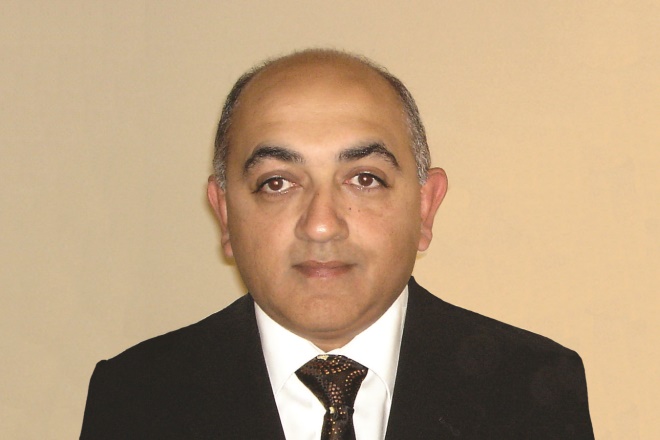
Source: Courtesy of Hitesh Patel
Hitesh Patel, chief officer at City and Hackney local pharmaceutical committee, says that some pharmacists may not find the £10 fee enough of an incentive to do offsite vaccinations
The ability to provide flu vaccinations at patients’ homes was only introduced in 2018, but the lack of any extra funding on top of the standard vaccination payment means the change has received a lukewarm response.
Hitesh Patel, chief officer at City and Hackney LPC, says: “Some pharmacists may not find the £10 fee enough of an incentive to do them offsite — especially if they have to get locum cover to do that. Some pharmacies which have a second pharmacist find it more commercially viable to do them.”
Surveys carried out on those who have had flu vaccinations suggest pharmacy does attract patients who otherwise would be unprotected against flu.
A PSNC patient questionnaire carried out during the 2016/2017 flu season found that 15% of those asked said they might not have otherwise recieved a vaccination if they had not visited their pharmacy, and that one in ten people who received the vaccination in a pharmacy had not been vaccinated in the previous year.
Friction with between services
But not everyone has been enthusiastic about pharmacists taking on the job of delivering flu vaccinations, including some GPs who are concerned about the potential impact on their practice’s income.
While some areas have seen successful collaborations between GPs and pharmacists on delivering the flu campaign, there have also been plenty of examples of underhand tactics being used to attract patients — perhaps an inevitable consequence of a system where both GPs and pharmacists rely on income from vaccinations, and one party fears being left out of pocket.
Patel says friction between GPs and pharmacists over the flu service is a “perennial problem”, with “some GP surgeries being particularly unprofessional”.
However, there are efforts in his area to ensure GPs signpost to community pharmacy if they run out of stock. Patel adds: “The LPC is in the process of creating a ‘live’ stock page on the LPC website for GPs to refer to.”
The point, he says, is to make sure uptake is as high as possible. “In City and Hackney, both community pharmacies and GPs understand that. Even with all the combined activity, the local and national targets are not being met.”
At the moment, it is a free-for-all with various tactics being used to coerce patients to get the vaccine in general practice rather than in the pharmacy, and possibly vice versa
A lot of work has been done at locality level to prepare for the flu season, and for pharmacies and GP surgeries to cooperate and avoid any scenario where a GP practice warns patients against getting their vaccination at a pharmacy — in a repeat of what some pharmacies experienced in 2017. However, some believe that with the unique circumstances of the 2018 flu vaccine campaign, that could all easily unravel. Shah points out: “At the moment, it is a free-for-all with some amazing tactics being used to coerce patients to get [the vaccine] in general practice rather than in the pharmacy, and possibly vice versa. This year we are already getting reports and it seems like it is even worse than previously.”
Hewitson agrees that this yearly point of friction is surprising given the normally good working relationships they have with local GPs. “The ill will it has created with some GPs is disproportionate to the financial impact on them,” he says. However, he adds that the problems with ordering and supply could perhaps de-escalate tensions because so much is out of the hands of GPs and pharmacists.
Despite all this, there are those who are hoping to outdo 2017’s success — in North Yorkshire, pharmacists delivered 18,797 flu vaccines in 2017/2018, beating the previous year’s tally of just over 11,000 by some margin. And they are not letting the supply issues deter them from a semi-serious target of 25,000 in 2018/2019. Kicking off the flu season with a photo opportunity of a local MP getting their vaccine, pharmacies in north Yorkshire administered 115 vaccines in the first week of the vaccination programme, compared with 46 vaccines during the same period the previous year, explains Jack Davies, chief executive of Community Pharmacy North Yorkshire LPC. And that figure is despite the first deliveries being patchy, with some pharmacies still waiting for stocks. “There was a lot of worry initially [among members] but that did settle down when the PSNC began to have concrete discussions.” They have worked hard to build relationships with local GPs and are not going to let the new challenges get in their way, Davies says.
What remains to be seen is whether pharmacist enthusiasm for the flu service can overcome the barriers that have been thrown up. As Shah points out: “At one of the meetings with many community pharmacists, I asked what it is that had most excited you in recent years with regard to pharmacy services, and what came up most was being able to do [flu vaccination] and hopefully other such clinical services.”
Panel
Total number of influenza vaccinations given in community pharmacies in England since 2015
- 2015/2016: 595,000 vaccinations
- 2016/2017: 950,000 vaccinations
- 2017/2018: 1.3 million vaccinations
